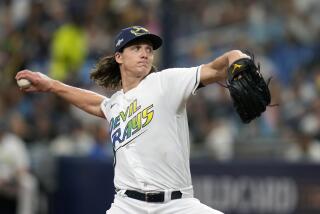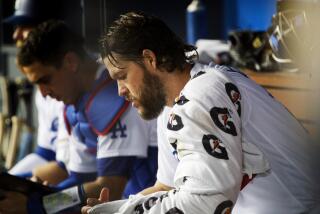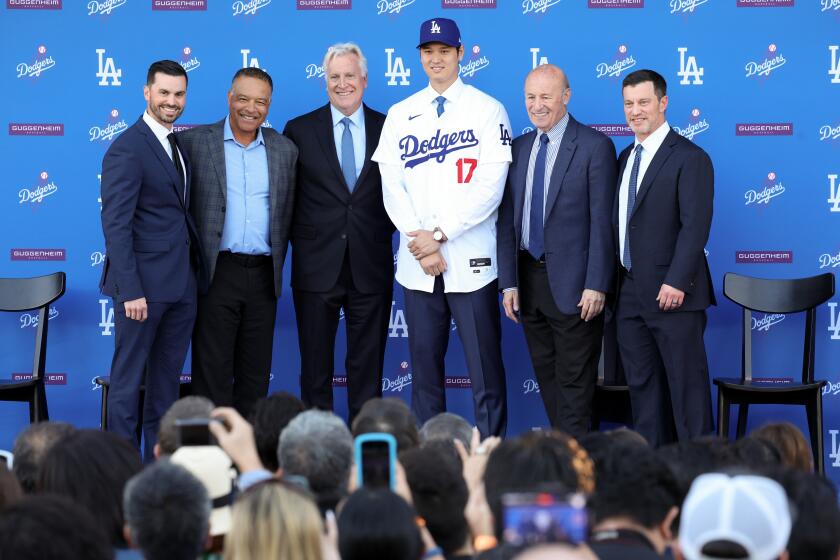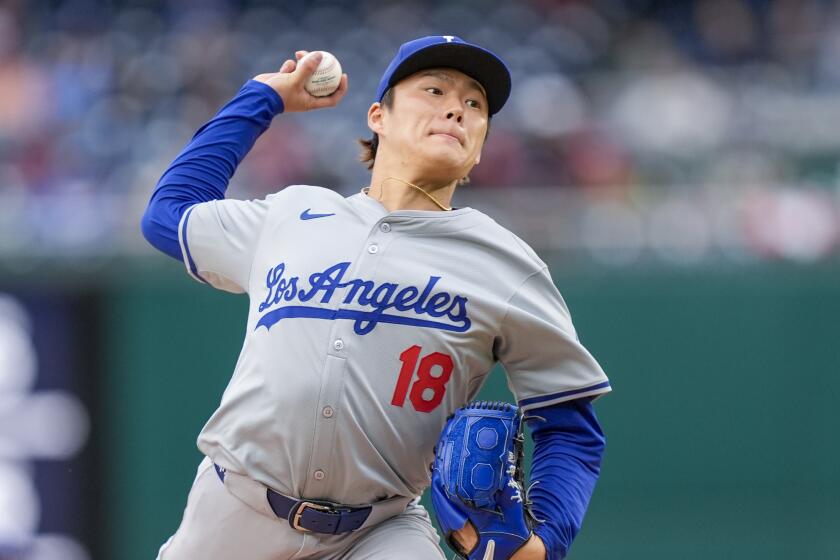Dodgers believe they’ve upgraded, but will that make grade with fans?

The Dodgers can no longer wait for Matt Kemp to rescue them with a home run.
In the wake of a frenzied 24-hour period during which they traded the 2011 MVP runner-up to the San Diego Padres, the Dodgers returned from baseball’s winter meetings with a new look.
In addition to Kemp, they unloaded second baseman Dee Gordon and pitcher Dan Haren. They picked up shortstop Jimmy Rollins, second baseman Howie Kendrick, catcher Yasmani Grandal and, very likely, pitcher Brandon McCarthy.
But are they better?
Andrew Friedman, the Dodgers’ president of baseball operations, won’t comment on the ramifications of Kemp’s departure until the deal with the Padres is finalized. However, he would have a tough time disputing the Dodgers are weaker offensively now than they were last season.
Following two injury-ravaged seasons, Kemp bounced back to hit .287 with 25 home runs and 89 runs batted in, with 17 of the home runs coming in the season’s final two months.
But with or without Kemp, the Dodgers lost production on offense when free-agent Hanley Ramirez and his middle-of-the-order bat signed with the Boston Red Sox.
Three days before trading Kemp, Friedman intimated the Dodgers might look for other ways to win when he said, “I’d be OK if we scored 200 runs next year if we allowed 100, just going to a crazy example.”
In other words, he didn’t mind if the offense was worse — just as long as the defense was better.
The Dodgers’ shortcomings on defense were obvious, and advanced analytics support the theory that Kemp and Ramirez were among the chief culprits.
Kemp registered a minus-23 in defensive runs saved, the worst among all qualifying major league outfielders, according to Fangraphs. Zero is considered average, 10 great, and minus-10 poor. Ramirez ranked sixth from the bottom among shortstops, at minus-six.
If the season started today, Yasiel Puig, an average defender according to Fangraphs’ metrics, would replace Kemp in right field. Carl Crawford, another average defender, would remain in left. Rookie Joc Pederson would be in center, and provided he is at least an average fielder, the Dodgers’ outfield defense would be improved.
The Dodgers also upgraded on defense at shortstop, where Rollins (four runs saved) replaces Ramirez, and at second base, where Kendrick (seven) steps in for Gordon (minus-five).
The Dodgers also view Grandal as a step up from incumbent catcher A.J. Ellis, and McCarthy as an improvement over Haren.
McCarthy’s 4.09 career earned-run average and 52-65 win-loss record are unspectacular, but the right-hander rates well in several advanced metrics that indicate, when healthy, he is one of baseball’s better pitchers. The main concern with McCarthy is durability; he has pitched 200 innings only once in his career.
There were also non-analytic considerations behind the front office activities. Josh Byrnes, the team’s new senior vice president of baseball operations, said clubhouse dynamics factored into the decisions made over the last week.
“I think that’s certainly part of it, especially with a high-payroll team,” Byrnes said. “We’ve got guys with great resumes, a lot of pride.”
By trading Kemp, the Dodgers hope to decrease the likelihood that one of their outfielders would complain about lack of playing time or moving to a new position. That same concern could lead to another move, one involving Andre Ethier, who would be on the bench again if Pederson starts in center field.
Pederson may have an opportunity unlike Dodgers prospects before him. When Kemp and Ethier reached the major leagues, they spent their first couple of seasons as part-time players. And Corey Seager, a 20-year-old infielder, could be on a fast track similar to that of Pederson. Rollins, 36, has only one year remaining on his contract.
What ultimately will determine the merits of this week’s deals is how the lesser-known additions turn out.
The Dodgers believe they received a tremendous return from the Marlins in exchange for Gordon, Haren and infielder Miguel Rojas. Pitcher Andrew Heaney was immediately flipped to the Angels for Kendrick. Three other former Marlins stuck with the Dodgers: reliever Chris Hatcher, utilityman Enrique Hernandez and minor league catcher Austin Barnes.
Hatcher is a converted catcher who posted a 3.38 ERA in 52 games with Miami last season. He had an outstanding strikeout-to-walk ratio of 5 to 1. Hernandez and Barnes are strong offensively and play multiple positions.
In 42 games with the Marlins and Houston Astros, Hernandez, 23, played every position except for first base and catcher. He also batted .319 in 98 games between double A and triple A. Barnes, who turns 25 this month, batted .304 in Class A and double A. He can also play second base.
From the Padres, the Dodgers added right-hander Joe Wieland, who was considered one of the top pitching prospects in baseball before he underwent Tommy John surgery in 2012 and another elbow procedure early this year.
But what the public thinks of these deals probably will be determined long before the careers of Hernandez, Barnes and Wieland are defined. Because the Dodgers traded one of the team’s most popular players in Kemp, they now face an uphill battle for widespread approval similarly encountered by defensive-minded basketball and soccer teams coached by men such as Ben Howland and Jose Mourinho.
They have to win right away.
Told the new front office would be intensely disliked if the trades didn’t produce immediate results, Byrnes laughed.
“I think that’s just the way the business works,” he said.
Follow Dylan Hernandez on Twitter @dylanohernandez
More to Read
Are you a true-blue fan?
Get our Dodgers Dugout newsletter for insights, news and much more.
You may occasionally receive promotional content from the Los Angeles Times.







